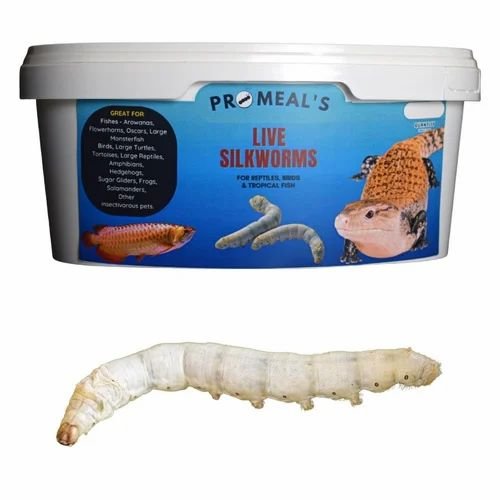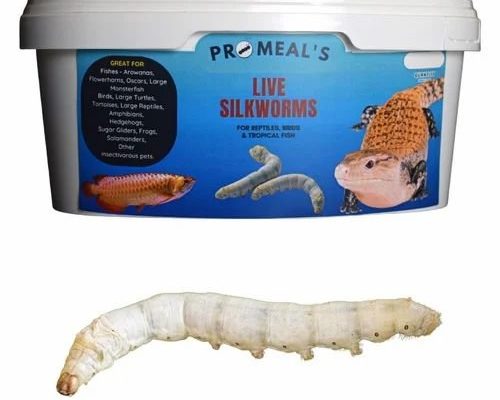
So, why should you consider silkworms? For starters, they are packed with protein and have beneficial fats and vitamins. It’s like feeding your pet a well-balanced meal that they’ll actually enjoy. Let me explain why these tiny, wriggly worms can be a great addition to your pets’ diets, how to feed them, and what you should keep in mind.
Why Choose Silkworms as Feed?
You might be wondering, “What makes silkworms stand out among other feeder insects?” It’s a great question. Silkworms are unique in that they carry a well-rounded nutritional profile. They boast high levels of protein, which is essential for the growth and health of reptiles and fish. In fact, the protein content in silkworms can be higher than that of crickets or mealworms.
Here’s the thing: not only are silkworms nutritious, but they are also soft-bodied. This makes them easier for smaller reptiles and fish to digest compared to tougher insects. Imagine trying to chew on a piece of tough beef jerky versus a tender piece of chicken—one’s a lot easier to handle! Additionally, silkworms don’t have the hard exoskeleton that some insects do, which can pose a choking hazard for smaller animals.
Silkworms also have a unique flavor that many reptiles and fish find irresistible. If your pet is a picky eater, introducing silkworms could be a game-changer. They might just gobble them up like candy! Plus, these worms can be an excellent way to enrich your pet’s diet, adding variety and excitement to their meals.
Nutritive Benefits of Silkworms
The nutritional profile of silkworms is like an all-star lineup for your pet’s health. Primarily, they are rich in protein, containing about 50-60% of their dry weight. This is fantastic for growing reptiles or fish that need extra energy for development.
Silkworms are also a good source of **essential amino acids**—the building blocks of proteins. For example, these worms contain amino acids like lysine, which is crucial for growth and repair. It’s like giving your pet a protein shake that directly fuels their muscles.
Moreover, silkworms provide healthy fats, vitamins, and minerals that are often lacking in a simple diet of crickets or pellets. With **omega-3 and omega-6 fatty acids**, they help maintain healthy skin and scales, which is vital for reptiles and fish alike. You wouldn’t want your pet to have dull skin or scales, right? It’s like how we want our hair to shine—healthy fats can help achieve that!
How to Feed Silkworms to Your Pets
You might be curious about how to incorporate silkworms into your pet’s diet. It’s pretty straightforward! First, you can purchase live silkworms from various pet stores or online retailers. Just make sure to source them from reputable suppliers to ensure quality.
When you’re ready to feed them, you can either give them as a treat or mix them in with other foods. If your pet is used to eating other insects, simply introduce silkworms gradually. Start with a few and see how they react. You could think of it like offering your buddy a new dish—you don’t want to overwhelm them!
It’s also essential to consider the **size of the silkworms** relative to your pet. Silkworms come in different sizes, and that’s an important factor. For smaller reptiles or fish, opt for smaller silkworms to avoid any choking risks. Always monitor your pet during mealtime to ensure they’re enjoying their new food without any issues.
Are There Any Risks?
As with any food, there are a few things to keep in mind when feeding silkworms. First off, it’s important not to overfeed your pets. Silkworms are high in protein, and too much can lead to obesity in reptiles or digestive issues in fish. Moderation is key!
Also, make sure to purchase silkworms that have been raised without harmful pesticides or chemicals. You wouldn’t want to feed your pets anything that could harm them. Always double-check the product information, especially if you’re buying them online.
Another consideration is that silkworms are primarily a protein source, and while they are nutritious, they shouldn’t be the sole component of your pet’s diet. Think of it like adding a side dish to a balanced meal. Silkworms can be a fantastic addition, but variety is crucial for their overall health.
Silkworms vs. Other Feeder Insects
You might be wondering how silkworms stack up against other feeder insects like crickets or mealworms. Let’s break it down. Crickets are widely available and are generally a staple in reptile diets. However, they can be more challenging to digest and may have fewer nutrients compared to silkworms.
Mealworms are popular too, but their hard exoskeleton can be tough on smaller fish and reptiles. Plus, mealworms are higher in fat, which can lead to obesity if fed too frequently. Silkworms, on the other hand, provide a more balanced nutritional option without the density of the hard exoskeleton.
So, why not rotate among all three? For a balanced diet, consider using silkworms as a treat and crickets or mealworms as staples. It’s a little like mixing up your lunch menu—variety makes meals more enjoyable!
Where to Buy Silkworms
Now that you’re excited about incorporating silkworms into your pets’ diets, where do you find them? Local pet stores often stock live insects, including silkworms. If you’re looking for a wider selection, several online retailers specialize in feeder insects.
When searching for silkworms, look for brands that focus on quality and health. Some popular options include **Bully’s Bugs** and **Coast to Coast Exotics**. They typically provide details about the worms’ care and feeding, which can help ensure you’re getting healthy products.
It’s also worth mentioning that you can raise your own silkworms if you’re feeling adventurous. They don’t require much space and can be a fun project. Just remember, raising your own requires a bit more commitment and knowledge about their care. But it could be a rewarding experience, much like gardening!
Final Thoughts
Silkworms can be an excellent addition to the diets of reptiles and fish. They offer a nutritious, tasty, and exciting option that your pets might just love. Plus, they help diversify your pet’s meals, keeping them engaged and healthy.
As you explore new feeding options, remember to introduce silkworms gradually and always maintain a balanced diet with various foods. With a little knowledge and care, you can provide your pets with the nourishment they need to thrive! Happy feeding!

